Siberia
Things to Do
Irkutsk
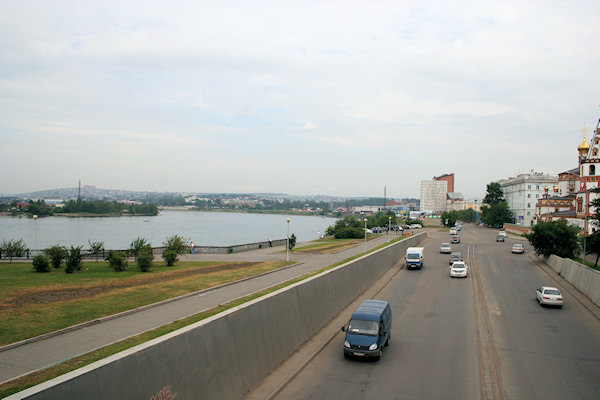 |
|||||
The Eastern Siberian city of Irkutsk is one of the oldest and most attractive Siberian cities.
It was founded in 1652 by Russian cossacks, to control the indigenous Buryats and now it is the capital of
Eastern Siberia.
It is situated in the south of Siberia, on the Angara River, near its outlet from Lake Baikal and it is
one of the largest Siberian cities, situated on the Trans-Siberian Railway.
Irkutsk was named for the small river Irkut, which flows into Angara river. The word "Irkut"
came from the languages of native Siberian people of Mongolian physical type. It is translated as speedy,
fast flowing river.
Irkutsk is famous for it's wooden architecture. It has preserved many of monuments including ancient
log structures. Some of the log structures have presently been restored. Almost all of the wooden houses
are privately owned.
The house is richly decorated with serous mostly of the Baroque style which was popular at that time.
Sculptered shutters are painted in blue and green. Blue is a symbol of hope and green is for long life and youth.
Also, white is symbolic of purification.
Church of Our Saviour
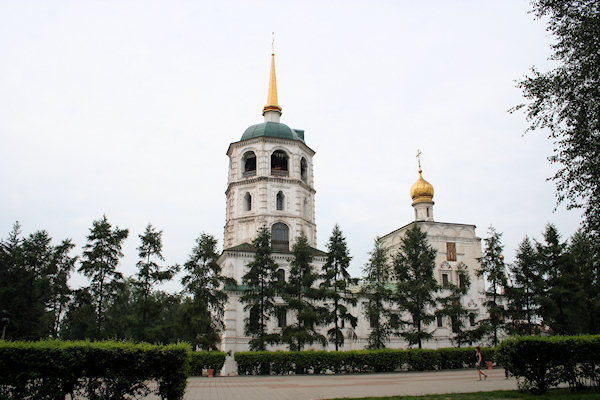 |
|||||
The Church of Our Saviour (Spasskaya) is the only one of the stone structure built in 1706 and
still standing.
A chronicle says: "This church was built through the efforts of the Irkutsk governor, Alexey Sidorovich
Sinyavin, with the participation of the townspeople. The high altar of the Saviour (Veronica) was
consecrated in this church on August 1, 1710."
Unfortunately the chronicle doesn't give the name of the church's builder but its austere proportions,
elaborate decor, ornate windows, the ornamental lines of its cornices and diversity of paintings set
against the restrained and modestly decorated exterior testify to the great taste and talent of its
builder.
Old Russian churches style was used here as the model and you'll feel an affinity with the architecture of
old Russia.
Later in 1758 a belfry was added to the church's western face. The restoration of the Church of our Saviour
was completed by Irkutsk masters in 1981.
The church now contains an ethnographic museum which is most exiting for allowing access to the bell
tower - great views if you're allowed to the very top.
Cathedral of the Epiphany
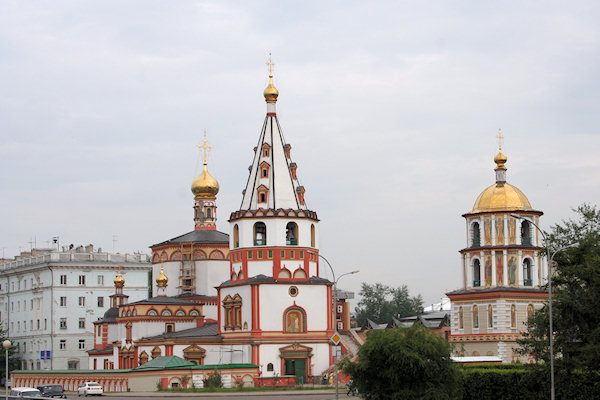 |
|||||
The Cathedral of the Epiphany (Bogoyavlensky) was originally wooden. But it was destroyed by the
great fire in 1716.
A new church was consecrated in 1723.
Its design was based on that of a church built in 1703 in the town of Verkhoturye in the Urals.
However, the Irkutsk builders merely made use of the fundamental constructional lines of the Verkhoturye
church to create a unique structure of their own.
Znamensky Convent
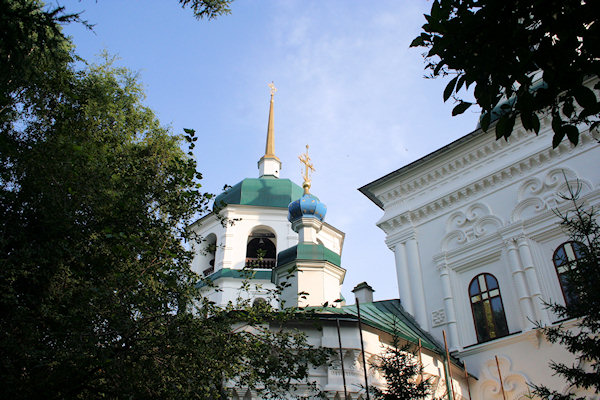 |
|||||
The former Znamensky (Sign) Convent was founded in 1683. The stone church was built later in
1762.
The lovers of architecture undoubtedly will pay attention to its decorative belfry, chetverik and exquisite
interior. Its wooden iconostasis and old-framed icons created by Irkutsk woodcarvers and icon painters are
still intact.
You can see here an old Gospel that was sent to the people of Irkutsk as a gift by Peter the Great in 1708.
A gold sarcophagus is holding the miraculous relics of Siberian missionary St Inokent
The graves of people whose names are inscribed in the history of the town, region and, indeed, of the
whole country are here within the walls of the convent.
Gregori Shelikhov (1749-95), a merchant, traveler and seafarer, who clamed Alaska for Russia.
Several Decembrists who lived in villages near Irkutsk after being freed from penal servitude. They are
Piotr Mukhanov, Nikolai Panov, Vladimir Bechasnov, Yekaterina Trubetskaya (1800-54), courageous woman,
Countess and a wife of Sergey Trubetskoy, one of the founders and leaders of the Northen Secret Society.
Monument to the Builders of the Trans-Siberian Railway
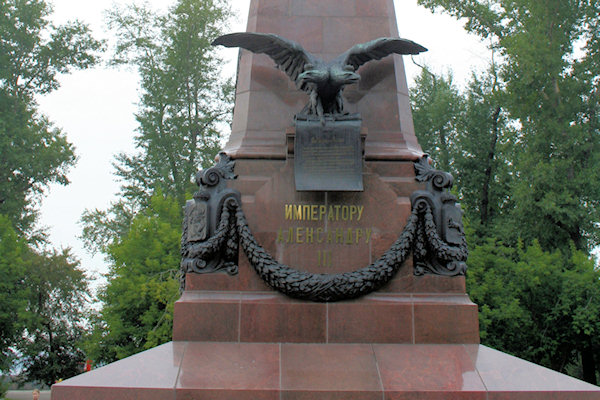 |
|||||
It was erected to commemorate the construction of Irkutsk Railway Station. The funds for the monument
were raised all over Siberia. You could hardly find a single citizen, regardless of class or standing who
didn't contribute something towards it.
The monument is consisted from the figure of Alexander III standing on the top of a pedestal. The
pedestal of red Finnish granite is decorated with the sculptured portraits of three people who were
directly involved in the conquest of Siberia:
Ermak Timopheyevich (unknown date of birth - 1585), Cossack chieftain. He paved with his campaigns
of 1581-85 the way for the annexation of Siberia to Russia and its conquest. He is the subject of many
popular songs and legends, 16th-century chronicles, novels, novellas and poems immortalizing his courage
and talent as a military leader.
Mikhail Speransky (1772-1839), Russian statesman, count, author of many bills and reforms in the
early 19th century. In 1819 he was appointed Governor-General of Siberia where he initiated reforms in the
region's management. On his return to St. Petersburg (1821) he became a founder of the Siberian committee
for the affairs of Russia beyond the Urals.
Nikolai Muraviov-Amursky (1809-81), Count, Russian statesman, diplomat and general. As Governor of
the Yenisei province, Governor-General of Eastern Siberia between 1847 and 1861, he did much to help the
development and study of the region, encouraged the local intelligentsia and political exiles to do
likewise, and treated the Decembrists liberally. He facilitated the development of the region, the
expansion of trade and supported geographical and exploratory expeditions, and as an emissary of Russia
signed the Aigun Treaty with China in 1858. He was bestowed the title of count and an epithet
Amursky was added to his surname for developing the Amur Region.
Buryatiya
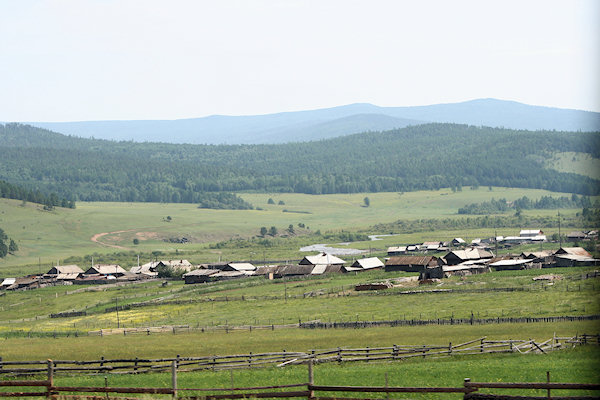 |
|||||
From the 6th to 11th centuries the Baikal shores, the lower reaches of the Selenga River, Tunkinski
valley region and the valleys of the Barguzin, Angara and Lena Rivers were inhabited by representatives of
the Turkic tribe called Kurikans.
In the early 13th century on the territory of Pribaikalye and Zabaikalye (western and eastern parts of
Baikal lake) settled Mongol tribes. As a result, the Buryat Nation had formed by the end of the 17th
century.
Buryats mostly engaged in hunting, fishing and gathering. The basis of their economy was intensive
cattle-breeding. In some areas Buryats grew millet, buckwheat and barley.
From Kurikans they inherited the high art of blacksmith work. They were also good at processing iron and
made from it weapons and utensils. Many Buryat people were highly skilled jewellers. Hometrade also
developed. Women made felt, with which they covered yurts, and dressed skin to make clothes and footwear.
Men usually prepared wooden frames of yurts, made carriages and weapons, wove ropes and sewed harnesses.
As a religion, Shamanism (it is a religion based on the beliefs in spirits) prevailed among the
Buryats. Gifted people, who were able to see connections in Nature and remember the regularity of
phenomena, stood out against the background. Such people were trusted and they and led the general
population.
These "shamans" (witch-doctors) appeared with the disintegration of the community. The shaman
attributes included a ritual costume, a drum, a crook, and images of spirits (ongohns). Pendants and bells
on the Shaman costume were considered a receptacle of spirits and were supposed to call them down or to
scare them away. The drum symbolized the Universe. While the shaman was passing into a trance the drum
played the part of the Supreme Beast. It also called spirits down and removed enemies. Shamans were the
first doctors who, tried to heal the body through healing its soul. They were also actors, prophets
and propagandists.
Lake Baikal
Olkhon Island
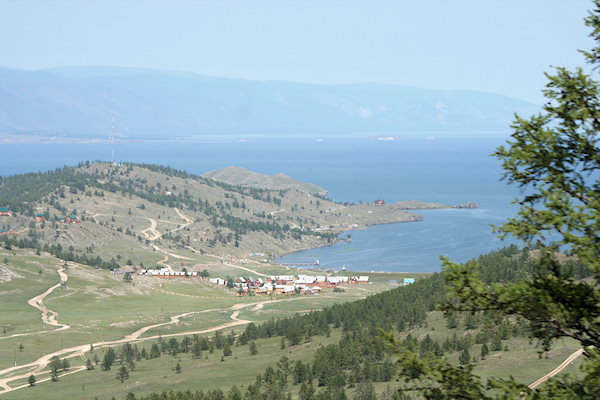 |
|||||
Invoking poetic images, it can be said that Baikal is the "blue heart of Siberia" and that
Olkhon is the heart of Baikal. Its length is 71,7 km, maximum width is 15 km, and the area is 730 sq. km.
It's name derives from the Buryat word "oi-khon" or "little forest", or "slightly
forest".
The island's population does not exceed 1.500 residents, most of them living in the largest settlement on
the island Khuzhir.
Olkhon lies in the middle part of the lake, near the maximum depth mark (1.625 m). It concentrates all the
diversity of nature landscapes typical of Baikal's shore areas. Even in it's shape does it resemble Baikal's
outlines. The highest point on the island is the Zhima Mountain, with its peak at an elevation of
1.274 m.
Olkhon is distinguished by a special climate; the summer here is warmer, and the winter is colder; high
winds are common during the autumn-winter season. A furious wind, Sama, suddenly assaults the island, tears
away the soil cover, and causes mutch troubles to fishermen.
For lovers of wildlife and for photographers it is a real sanctuary of remarkably varied landscapes and
majestic sceneries.
Throughout most of the year the island offers favorable conditions for tourists and for fishing. They can
undertake hiking, automobile and aquatic automobile, horse-back and bicycle tours.
From may to december the island communicates with the mainland via the ferry. Motor cars traverse the lake
on the ice in the winter, and it is only by airplane that you can reach the island during the freezing-over
and break-up period.
Khuzhur
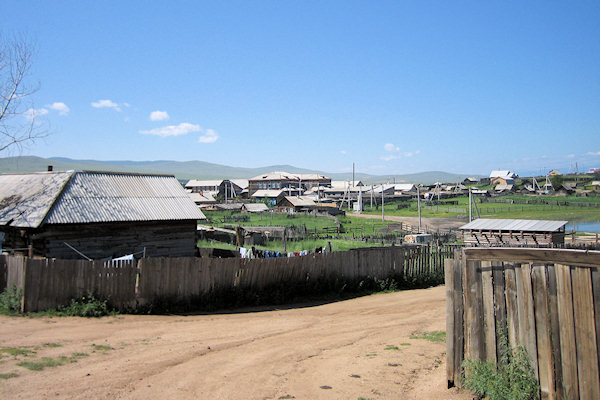 |
|||||
Khuzhur is the main village on Olkhon island. There are a few thousands inhabitants, and it is
quite a calm place. All shops and little cafes are located near the main square of the village, and you
can buy everything you may need there: from bread, water, juices, and beers, to fresh vegetables and
fruits, milk, cheese, and crops.
In Town there is also nice small museum; worth to take a look.
Shaman cave is a sacred place in Khuzhir, on the shore of Baikal lake. It is believed to have
supernatural powers by Shamans, but as it is the main tourist attraction, it became quite spoiled.
North of the cave; there are some nice sand-beaches. The beaches are open to everybody, so there a many
tourists coming there by car for Summer, but the place is so vast, they don't seem to disturb each other.
In Town there is also nice small museum; worth to take a look.
Three Brothers Rock
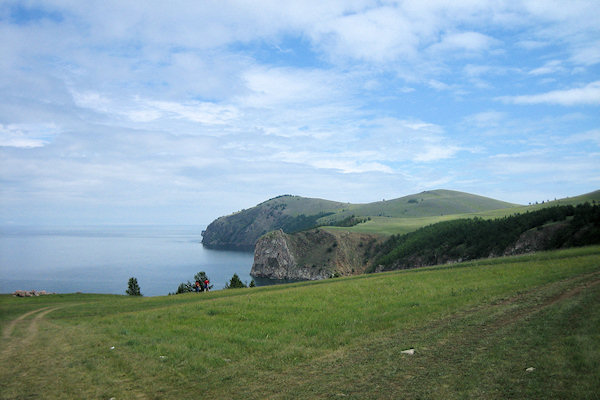 |
|||||
Three Brothers Rock is a must-stop for every tour around the Island. The three rocks standing in
a row overlooking Baikal lake.
The old Buryatian legend explains their appearance.
"In the old times there lived three brothers. Their father was a very powerful entity and he turned
his sons into eagles. They were enjoying the freedom to flight where they want and thanked their father
for that. However, he told his sons that by no means they should eat dead meat. The sons promised not to
do that, but once, when they were flying above the island, they were very hungry, and found a dead animal.
Despite their vow, they ate this dead animal. When their father learned about it, he was very furious,
and to punish his sons he turned them into three rocks.
Cape Khoboy
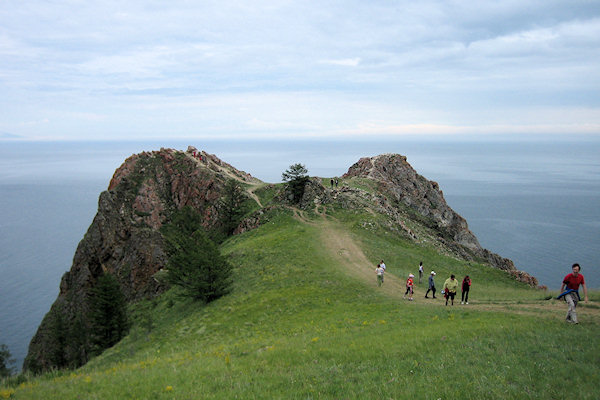 |
|||||
Cape Khoboy (in Buryat, Khoboy means 'tusk') is the northernmost point on Olkhon Island.
It is one of the most sacred places on Baikal, where where the outline of mountains and the
Svyatoi Nos peninsula can be seen in the distance, making up the background to the seemingly
endless blue of the lake.
Trans-Siberian Railway
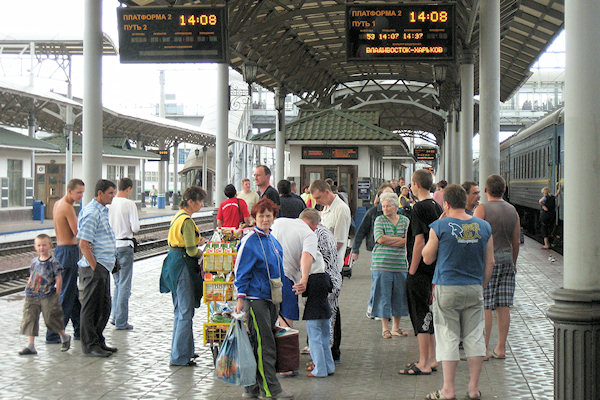 |
|||||
Extending 9.289km from Moscow to Vladivostok on the Pacific, the Trans-Siberian railway
and connecting routes are one of the famous and potentially enjoyable of the world's great train journeys.
Don't look for the trans-Siberian Railway on a timetabl, though, the term is actually used for the following
main lines:
- ROSSIYA: Moscow - Vladivostok
- BAIKAL: Moscow - Irkutsk
- TRANS-MONGOLIAN service: Moscow - Ulaan Baatar - Beijing
- TRANS-MANCHURIAN sercice: Moscow - Harbin - Beijing
Prior to the Trans-Siberian Railway, crossing Siberia was a torturously slow and uncomfortable business.
In fact, it was quicker to travel from St. Petersburg to Vladivostok by crossing the Atlantic, North America
and the pacific than by going overland.
In the 19th century, as the region's population grew, and both Japan ans China began coveting Russia's
far-eastern territories, The Russian Empire realised it needed better communication links with its
extremities. Ideas for a railway across Siberia were floated, but it wasn't until 1886 that Tsar
Alexander III finaly authorised the building of a 7.500km line from Chelyabinsk (then
Russia's eastern railhead) to Vladivostok.
A route was cut across the steppe and through the taiga woth hand tools. The labour force was made up of
exiles and convicts (offered reduced sentences as an incentive), soldiers and imported, paid Chinese
laboures. Due to the terrain, climate, floods and landslides, disease, war and bandit attacks, not to
mention shoddy materials and bad planning, the railway took 26 years to build.
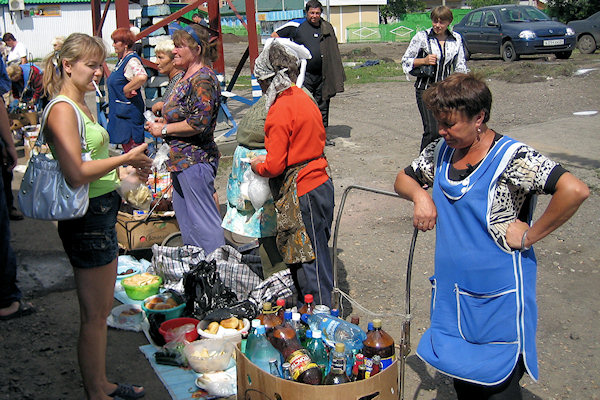 |
|||||
It's a safe bet you won't go hungry. On long trips Russian travellers bring great bundles of food that
they spread out and, as dictated by railway etiquette, offer to each other; you should do the same.
Always remember to bring along bottled water for the trip, although every sleeping carriage has a
samovar filled with boiling water that's safe to drink and is ideal for hot drinks or instand
noodles.
The quality of food in dining cars varies widely. rather than for eating they become the place to hang out,
drink beer and play cards. Generally, Russians love speaking with foreigners and they love drinking with
them as well. Choose your drinking partners carefully and only drink from new bottles and only when you
can watch the seal being broken, course there is a lot of homemade stuff around.
Shopping for supplies at the stations is part of the fun of any long-distance Russian train trip. The
Babushkas offer an exellent choice of items: fresh milk, ice cream, grilled chicken, boiled potatoes,
home cooking such as pelmeni (Russian-style ravioli dumplings) or pirozhi (savoury pies),
buckets of forest berries and smoked fish. Prices are low and it's a good idea to have plenty of small
change on hand.